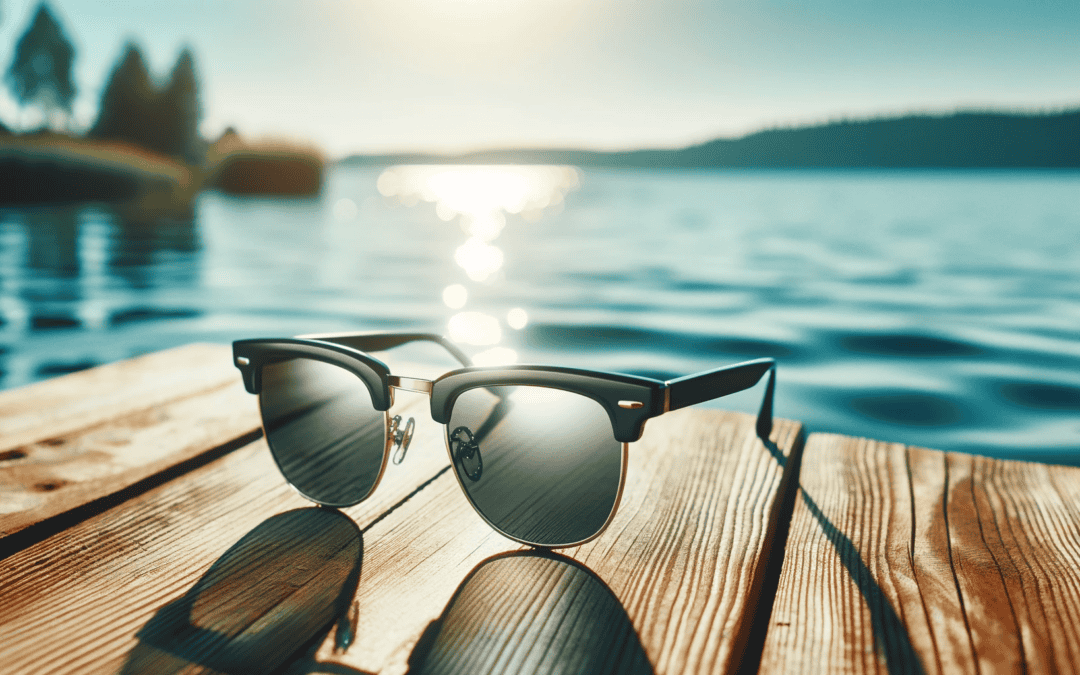What do Polarized Lenses do?
Photographers often use polarized lenses on their cameras to obtain bolder colors and deeper contrast in their photos. In the same way polarized lenses remove the glare and improve the visual quality of a photograph, polarized ophthalmic lenses improve the vision and comfort of those wearing them, in addition to playing an important safety role for drivers, particularly in morning and late afternoon sun.
Imagine standing on the shore in the early morning, the bright sunlight reflecting off the surface of the water into your gaze. There is a boat in the water, but you can barely see it because the intense reflected sunlight fills your eyes. You put on your polarized sun glasses. The intense reflected sunlight is replaced with a scene full of detail, color, and contrast. That is what polarized lenses do. Next, imagine a similar scene where instead of standing on the shore, you are driving your car and the sun is reflecting off the wet pavement. Instead of a boat being obscured by the glare, a child is crossing the road - now consider the important safety role polarized lenses can have in everyday life.
When to Choose Polarized Glasses
Many who wear polarized sunglasses report feeling less fatigued after prolonged exposure to sunlight, attributing this to reduced glare. Polarized sunglasses are an excellent choice for various day-to-day activities, offering specific advantages in certain environments:
- Fishing: Anglers often notice a significant reduction in surface glare, improving their ability to see beneath the water's surface.
- Boating: Spending extended periods on water can lead to eye strain. Polarized lenses not only reduce this strain but also enhance underwater visibility, crucial for safe boating.
- Golfing: While opinions vary, some golfers find that polarized lenses hinder their ability to read greens accurately. However, these lenses effectively reduce glare on the fairways. Golfers can always remove the sunglasses while putting, if preferred. Additionally, polarized lenses can make spotting golf balls in water hazards easier.
In snowy conditions, where glare is prevalent, polarized sunglasses are generally beneficial. However, there are situations where they might not be the ideal choice.
When to Avoid Polarized Lenses
Polarized lenses are not always the recommended option, particularly in the following scenarios:
- Viewing LCD Screens: This includes car dashboard displays, ATM screens, cell phones, and some digital watches.
- Situations Where Glare is Useful: Such as detecting ice on roads while driving or icy patches while skiing.
- Night Driving: While there are polarized glasses marketed for night driving, they may reduce visibility more than they aid in glare reduction.
UV Blocking and Polarization
It's important to note that UV protection and polarization are not synonymous. Sunglasses that block harmful ultraviolet rays might not necessarily be polarized. Polarized lenses should be explicitly labeled as such.
Polarized lenses are available in all lens materials. Only glass lenses (to a much lesser degree, plastic) do not provide significant inherent UV protection.
How Do Polarized Lenses Work?
Light waves coming directly from the sun vibrate in all directions and are considered non-polarized. When vibration is restricted to a single direction or plane, the light is considered polarized. When non-polarized sunlight is reflected by surfaces, it can become polarized as light of all but a single angle is either absorbed or scattered. Bright, flat surfaces such as water, wet roads, sand, snow, car hoods, and windshields are major sources of reflected polarized light. The intensity of this reflected light can obscure useful information about the color, texture, and other properties of the underlying surface and can be visually uncomfortable or constitute a safety hazard. The good news is this reflected light can be virtually eliminated by using polarized filters.
The principle behind polarized lenses is perhaps best illustrated by thinking of the lens containing a microscopic Venetian blind. The blind blocks the transmission of light from certain angles while allowing it from other angles. The blinds are aligned horizontally to absorb the reflected light that degrades vision. The horizontal alignment can be demonstrated by taking a pair of polarized sunglasses outside on a sunny day. Find a reflection of sunlight on the hood or windshield of a car. Hold the sunglasses in front of your eyes and view the reflected sunlight through the polarized lenses. Notice the intensity of the reflection drop dramatically. Now rotate the sunglasses 90°, just as if you were to tilt your head to one side or the other, and notice the intensity of the reflection return illustrating how the horizontal alignment of the polarizing filter interacts with the reflected polarized light. This horizontal alignment makes correct placement of the polarized lenses in the wearer's frames imperative.
Polarizing filters are created by stretching sheets of polyvinyl alcohol (PVA) so its molecules align in long directional chains. The PVA is then passed through an iodine solution where the light absorbing iodine molecules attach to the molecular chains forming the microscopic blinds. The film is then incorporated into the lens blank as it is poured, creating polarized lenses.
Are Polarized Sunglasses Better Than Tinted Lenses?
Although tinted sunglasses may reduce brightness and improve wearer comfort, they do not remove glare like a polarized lens. Moreover, dark sunglasses without UV protection (sometimes found in cheap sunglasses with plastic lenses) can potentially do more harm than good as the darkness of the lens can cause the pupil to dilate, allowing damaging ultraviolet rays into the inner parts of the eye. Polarized lenses provide the comfort of darkened lenses, eliminate uncomfortable and often dangerous glare, and filter harmful ultraviolet light.
Digital Screens and Car Windows
There is an interesting visual phenomenon associated with polarized lenses, one that allows stress patterns in certain materials to become visible to wearers of polarized lenses. The effect can most often be seen in the car windows as a cross hatch pattern in the glass. Auto glass is tempered for safety. This tempering induces stress that becomes visible when viewed through polarized lenses.
Similarly, ophthalmic lenses can be checked for stress by holding them between two polarized lenses with light shining through. Any amount of stress in the lens material becomes evident. The process works for lenses of any material and is the only way to detect unwanted stress that could ultimately result in a broken lens. This unusual feature of polarized lenses has no effect on acuity or vision, but it may help to explain this characteristic of polarized lenses to anyone purchasing or considering polarized sunwear.
Most modern digital screens, such as those on smartphones, tablets, and computer monitors, use a form of light polarization as part of their display technology. When viewing these screens through polarized lenses, users might notice a reduction in screen visibility or a darkening effect. This occurs because the polarizing filter in the lenses can block some of the light emitted from these screens, especially when the screen is viewed at certain angles. In some cases, the screen may appear almost completely black or very dim when viewed through polarized sunglasses.
While polarized lenses offer significant benefits for outdoor use, particularly in reducing glare from bright surfaces and improving visual comfort and clarity, they may not be the optimal choice for prolonged use of digital devices. Users who rely heavily on digital screens for work or leisure might prefer non-polarized lenses or specialized computer glasses designed to reduce digital eye strain. These alternatives typically do not interfere with screen visibility and may include additional features like blue light filtering to enhance visual comfort during prolonged digital device use.
Polarized Colors, Efficiency, and Use
|
|
Using AR Coating on Polarized Sunglasses
Something else to consider when dispensing polarized lenses; most high-end sunwear manufacturers, in addition to using polarized lenses, add an AR coating to at least the back surface of the lenses. While polarized lenses reduce reflected light from external surfaces, AR coatings reduce reflected light both in and on the lens itself. Reflections on lens surfaces, most significantly back side reflections are far more noticeable in dark lenses and can sometimes even dramatically impair vision. An AR coating eliminates these reflections and improves visual clarity. While it can be argued that the most benefit is derived from back side AR coating, front side AR coating carries the same benefits outdoors as it does indoors. Furthermore, a flash mirror provides an attractive look when added to the front side of polarized lenses. Make a habit of recommending polarized lenses with front and back side AR coating to your prescription sunwear patients.
Can Polarized Lenses Be Clear?
No. While lenses are available with different degrees of polarization, the process involves the application of a special film on the lens. When this film is aligned in a specific direction, it blocks certain light waves. Therefore it is not possible to have clear polarized lenses; they will always have some degree of light-blocking "tint."
Can Photochromic Lenses Be Polarized?
Photochromic lenses are not polarized. However, Drivewear is an example of a sun lens that combines a polarizing filter with a photochromic layer that gets even darker in bright outdoor conditions.









